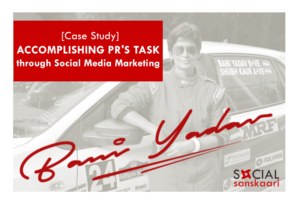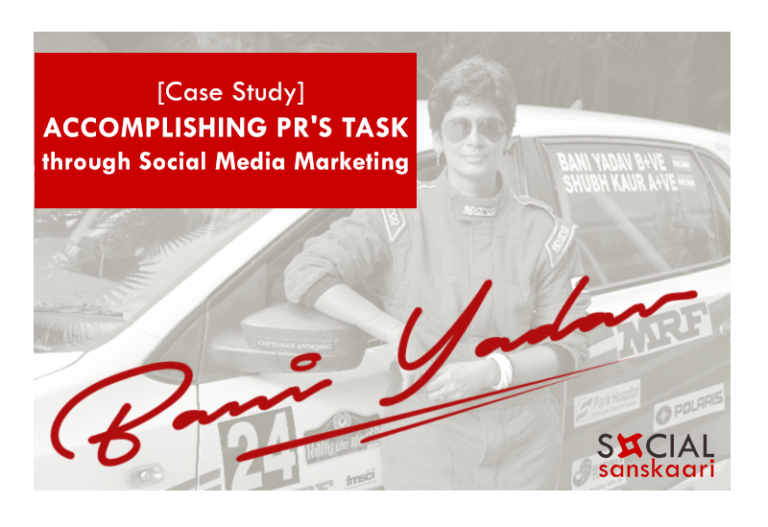How Social Media Marketing does a PR’s task?

The main role of Public Relations is the reputation management and image building of a person or business. PR provides an exposure to their audiences using various media tools.
Publishing news releases and articles in news paper or airing information on Television or radio are some of the most commonly used mediums. However, Social Sanskaari is changing the way brands and celebrities build their image. Social media can be leveraged strategically to effectively handle a PR’s task for any brand or celebrity.
CASE STUDY
Here’s a case study on how Social Sanskaari executed a 360 campaign for establishing and promoting a motorsport personality on digital platform. Following are the details how leads were generated and the follower base was converted into a loyal community for on-ground activities.
TASK:
Celebrity management is generally considered as a PR job. Mainstream media, like TV, newspapers and radio is the first preference for celebrities to increase their reach. But, they are the expensive mediums to approach. Hence, we took the plunge of taking the digital route to build the celebrity brand- Bani Yadav.
CHALLENGE:
Motorsport is a male-dominated, not-so-popular-sport in India. Hence, creating & positioning a woman belonging to such sport was a challenge.
SOLUTION:
The motorsport queen of India was bringing all laurels to her name on the tracks. Hence, we created social media channels to direct her on-field followers on one official channel and further building & strengthen the community of the sport-lovers and Bani’s fans.
EXECUTION:
Digital Autograph- An autograph is the first thing that followers seek from a celebrity. Hence, we used a digital autograph as the logo to leverage the sentiment associated to an autograph with the image of Bani Yadav.
Image Building – Associated various women centric campaigns that talks about women empowerment, breaking stereotype and determination to showcase her Bani Yadav’s early struggle and determination to be the fastest women rallyist in India.
Following are the few successful campaigns executed on social media:
#SteeringChange stimulated the right pulse of the target audience.
#WomenOnWheels was an on-line contest to promote motorsports among women, with an offline integration activity to create buzz among the followers on the digital platforms. Huge number of followers participated in the contest, where their motorsport IQ was tested and winners got a chance to meet Bani Yadav in person.
#DriveWithBani is a successful example of an online-led offline campaign, where women were invited to participate (at a nominal fees) in a motorsport event at Off-Road Adventure Zone, Gurgaon. The success of the #DriveWithBani can be inferred from 3 successful editions that were organised monthly.
#MotorMissy club was formed after 3 successful editions of #DriveWithBani campaign created an audience base and a strong community, which helped Bani Yadav form India’s first all-women motorsport training club.
RESULTS:
Multiple editions of the campaign were organised, which itself narrates the success of the idea, execution & implementation of the entire campaign. The on-ground activities witnessed huge number of participants directed from online promotions. Moreover, all these campaigns garnered good media attention from India’s leading newspapers.
Related Posts

How Social Media Marketing does a PR’s task?
How Social Media Marketing does a PR’s task? The main role of Public

Dos and Do Nots of Social Media Marketing
Social media marketing is essential for any business these days. If you don’t

Web Design Vs Web Development: the Biggest Differences
In this world of technology, The terms web design and web development are
About Me

Hello, my name is caitlyn vine jony.
my job is to do lovely things to fill my
little house in my free time.
Let’s Socialize
Subscribe to our newsletter and stay updated to our offers and deals!
We are committed to protecting your privacy

How Social Media Marketing does a PR’s task?

Dos and Do Nots of Social Media Marketing





